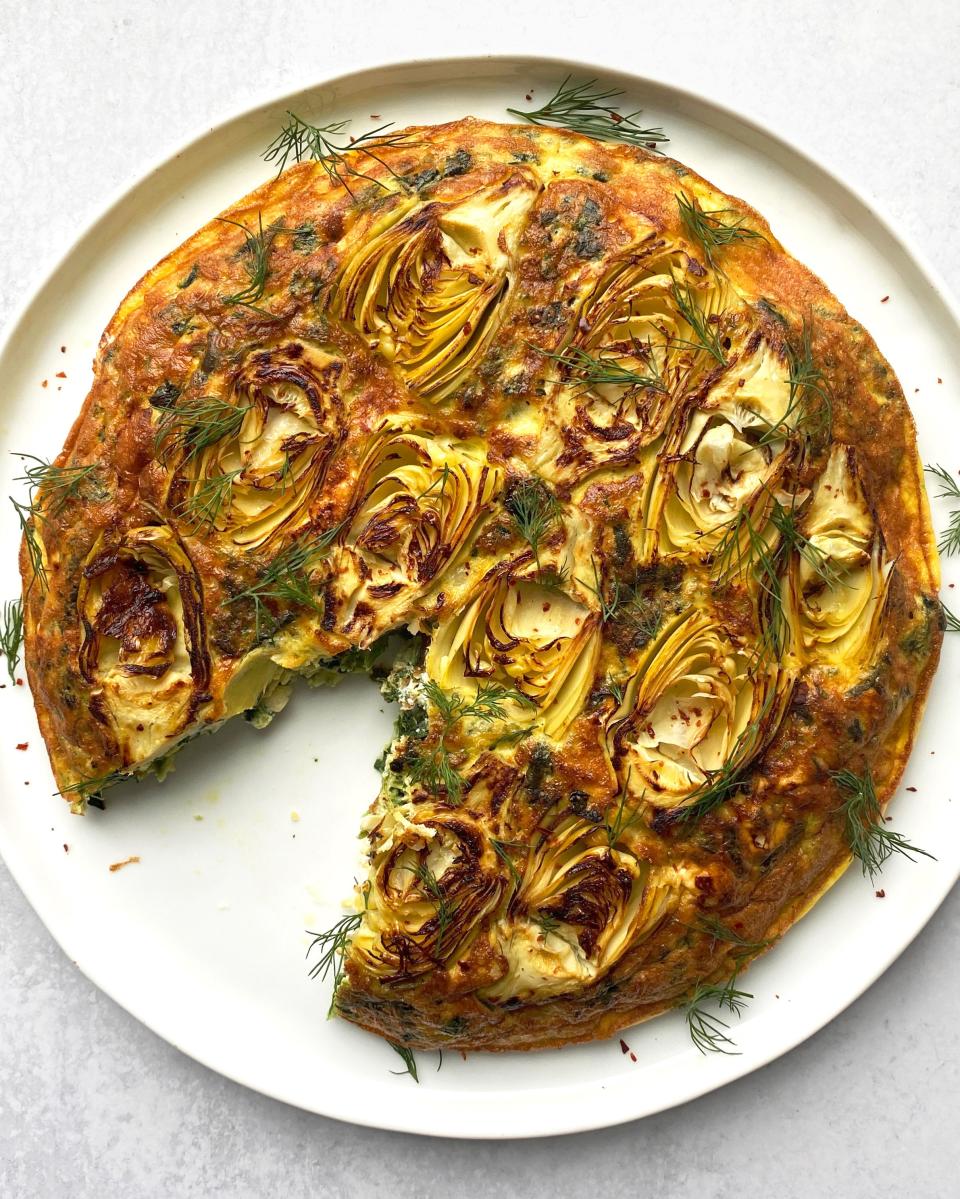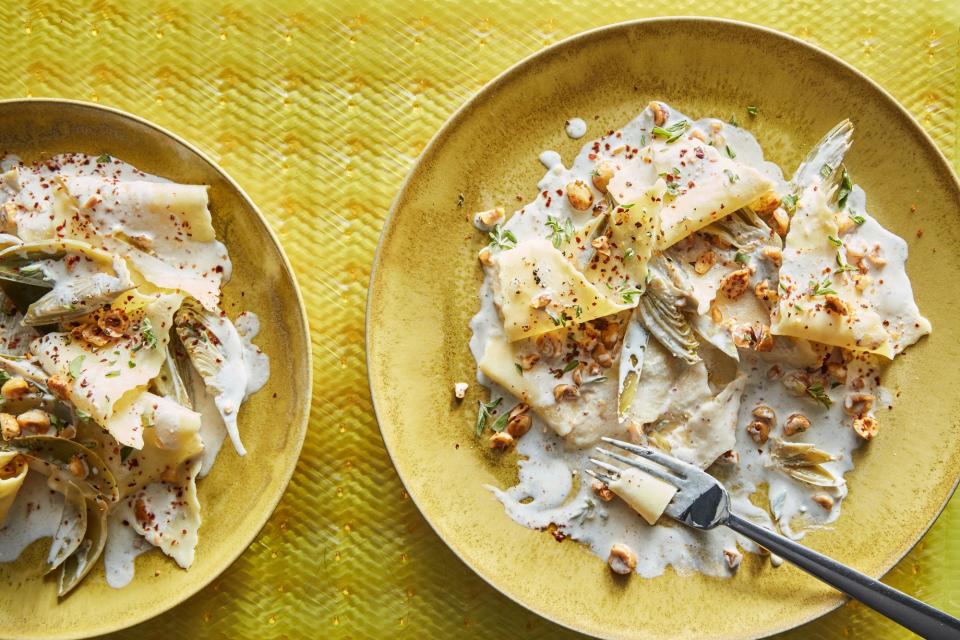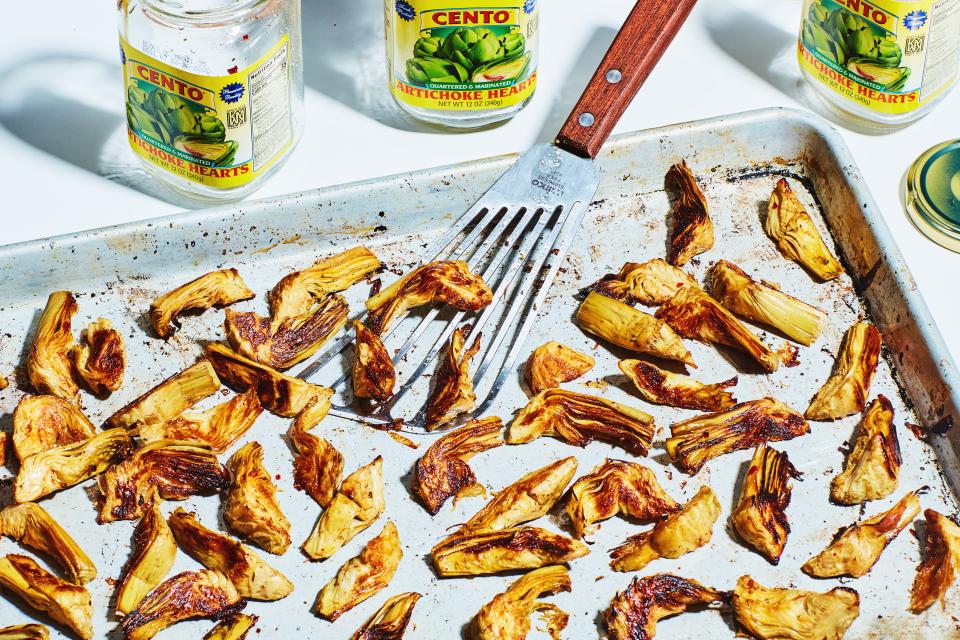How to Prep and Cook Artichokes
I'm not going to sugarcoat this: trimming an artichoke (also known as turning or paring) the classic French way is a labor of love. The leaves are prickly, and you have to cut away about 75 percent of the vegetable before you reach the edible portion. However, there are shortcuts: ways to prepare artichokes that require less time, less fussiness. Whether or not you can deploy these tactics is a matter of how you want to cook them—or not cook them, as it were.
Artichokes (which are actually categorized as flowers, botanically speaking) can be eaten raw if you'd like. They can also be steamed, roasted, fried, braised, or grilled. The one thing that I would recommend, if you're choosing to prep and cook fresh artichokes, is that you make a dish in which the artichoke is the true star. Our digital director, David Tamarkin has gone on record as a person who will only use canned artichoke hearts. And it's true that if you plan on blending them into a dip or tossing them into a salad or a braise with a lot of big, bold flavors, relying on canned (not marinated) or frozen artichokes may be the way to go. But, if you're here because you want to highlight the buttery, grassy, fresh flavor of artichokes in season, keep reading for all the ways to treat them right.
A spin in the oven gives marinated artichoke hearts a flavor boost you never knew they needed.
How to Prep Artichokes
The first step for prepping artichokes, no matter your chosen method, is to fill a bowl with cold water and squeeze the juice from at least half a lemon into it. This acidulated water will serve as a resting place for the trimmed vegetables while you work on the remaining ones. Without the lemon, the artichokes will quickly turn brown (like a cut apple). If you ever feel like you're moving slowly, give the artichoke-in-progress a dunk or rub the cut lemon over the expose flesh to mitigate oxidation.
Fill a large bowl with cold water and squeeze in the juice from half a lemon or a whole lemon if working with a very large batch. You can toss the rind into the water too, if you like: some flavor will be pulled out of the zest at it sits.
Using a serrated knife, and working with one artichoke at a time, cut the top 1 inch of the artichoke and discard the prickly leaf tips.
Cut half an inch from the bottom of the stem. It should have a white or pale yellow center point with a bright green burst of color all around. If the color looks dull, cut a little more off, but remember: the stem is edible (and some say the best part) so don't cut away too much.
Using your hands or a paring knife, peel or cut away the dark green, leathery outer leaves. Stop once the leaves feel more flexible and you've reached leaves that are medium green at top and pale yellow at the stem end.
Use a small spoon or melon baller to dig into the core of the artichoke and scrape away the hairy center (this is the choke). Get it all out and discard—this part is not edible.
Use your paring knife or a vegetable peeler to trim away any dark green remaining on the base and to peel away the tough skin of the stem.
Drop your trimmed artichoke, aka artichoke heart, into the acidulated water and continue with the rest of your artichokes.

3 Eggs + A Spinach Artichoke Dip Quiche - IG
The Faster Way to Prep and Cook Artichokes
A popular way to prepare artichokes is to steam the heads whole or halved. The cooked artichokes are then eaten by pulling a single leaf from the base, dipping the bottom of the leaf in olive oil, melted butter (made even better by infusing herbs and spices), or mayonnaise, scraping the meaty portion at the base of the leaf with your teeth, and then discarding the remaining tough leaf. It makes for a great appetizer—or dinner for one.
Have a steamer basket ready in a large pot with a couple inches of salted water simmering away.
Cut the top half to 1 inch off the artichoke and discard the prickly leaf tips. If anyone with more delicate hands will be enjoying the finished dish, you may want to use a pair of kitchen shears to cut the tip of each still intact exposed leaf to avoid the possibility of getting pricked.
Trim about half an inch off the stem and then use a paring knife or vegetable peeler to remove the tough dark green skin from the stem.
Cut the artichoke in half lengthwise (or leave whole if you prefer, but this will take longer to cook) and use a spoon to scrape out and discard the hairy center (this is the choke).
Set the artichoke halves cut side down (or the whole artichoke top down) on the basket and cover. Cook for 15 minutes (about twice as long for a whole artichoke), or until a leaf can be pulled off the base without any effort. Remove from the heat, cool to the touch, dip each leaf in something delicious until only the precious heart remains. Devour it too.
How to Prep Baby Artichokes
Baby artichokes are slightly easier to prepare because they haven't formed as much tough exterior as their larger cousins—they also usually haven't developed the hairy choke, so you won't need to worry about scraping it away.
Fill a large bowl with cold water and squeeze in the juice from half a lemon or a whole lemon if working with a very large batch. You can toss the rind into the water, too, for a bit of extra flavor..
Working with one artichoke at a time, cut about a quarter inch off the top of each artichoke. Trim stem, leaving at least half an inch intact.
Cut artichoke in half lengthwise, then use your hands to peel away the tough dark-green outer leaves until you reach tender bright-green leaves that bend easily.
Drop your trimmed artichoke into the acidulated water and continue with the remaining veg.

Pasta with Baby Artichokes, Mascarpone, and Hazelnuts
How to Cook Artichokes
Artichokes can be cooked (or, ahem, not cooked) in a variety of ways. Here are a few of our favorite preparations:
Raw: Cut or shave raw artichoke hearts into thin planks and then dress with a bright lemon dressing and toss with Parmesan cheese. Get the recipe.
Steam: See above for faster way to prepare artichokes. Get the recipe.
Grill: Trimmed baby artichokes can be placed directly on a grill over medium-high heat to char and steam. Larger artichokes will need to be par-cooked first, usually by steaming or blanching. Get the recipe.
Roast: Toss trimmed artichokes with the rich, winey juices from a roasting lamb shoulder and then scatter them around the meat and continue to roast until both chokes and lamb are tender and succulent. Get the recipe.
Fry: Blanch sliced artichoke hearts into long strips and then drain and dredge in a tempura-like batter. Fry until golden and crisp and serve with a green goddess dipping sauce. Get the recipe.
Braise: Rub trimmed, halved artichokes with a minty pesto and then tuck them into a bubbling tomato sauce. Cover and cook for about 40 minutes. Get the recipe.
Braised Artichokes with Tomatoes and Mint
Bon Appétit
Originally Appeared on Epicurious



